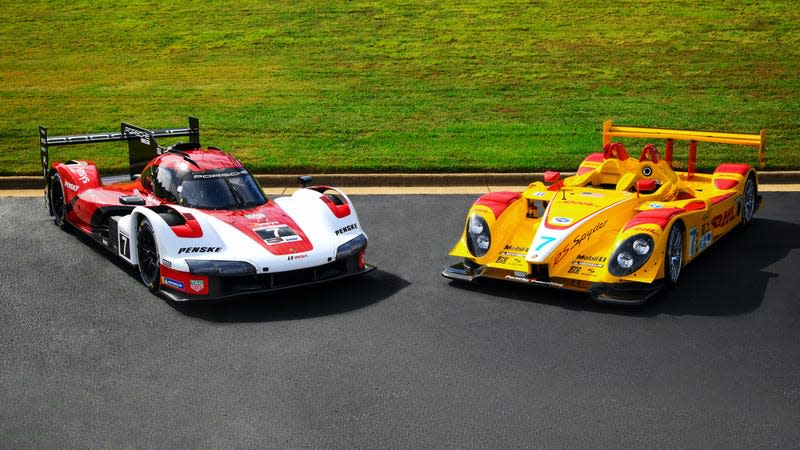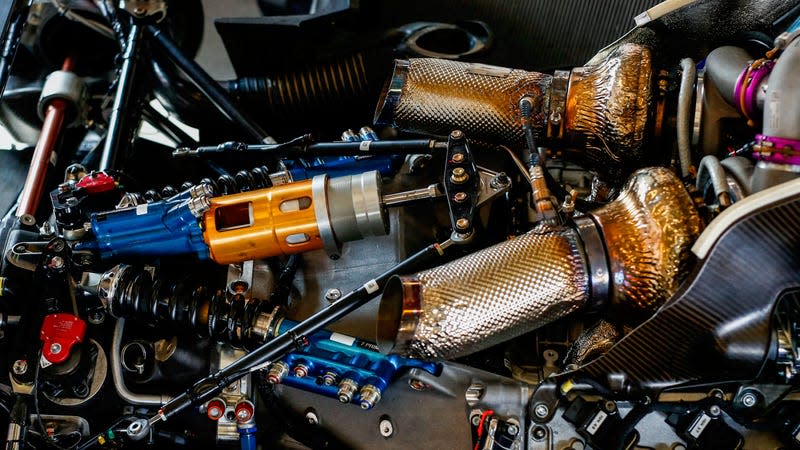How Porsche Adapted the 918 Spyder Engine for the New 963 GTP Hypercar

The last time a V8 powered a Porsche prototype race car was nearly two decades ago in the RS Spyder that competed in the American Le Mans Series (ALMS) LMP2 class. The LMP2 car may have experienced some growing pains at first, but overall it was incredibly successful, winning the championship title every year it ran in the series, from 2006 to 2008. When it came time for Porsche and Penske Motorsport to return to the next-generation Prototype class in both IMSA and WEC, it was only natural for the team to borrow from its winning roots. The V8 engine in the 963 you’ll see on track this weekend at the Rolex 24 at Daytona has a direct connection to the Porsche V8 that dominated ALMS — and powered the road-going 918 Spyder hypercar.
From LMP2 to 918 to 963

“7 and 7": On the left, the 2023 Porsche 963 LMDh car. On the right, Porsche’s winning LMP2 prototype competitor for the ALMS series.
Jalopnik sat down with Thomas Laudenbach, VP of Porsche Motorsports, at IMSA’s final test for the Prototype class in December. Laudenbach was in charge of the engine department for Porsche and Penske Motorsport’s LMP2 efforts in the mid-2000s. The 3.4-liter V8 that powered those winning cars provided the basis for the 4.6-liter twin-turbo V8 in the new 963.
Read more
“Obviously, at that time it was a smaller cubic capacity, but it’s the same architecture,” Laudenbach told Jalopnik. But the 3.4-liter would go through another evolution before making it into the 963.
For the 2023 IMSA season, Porsche needed an engine that would work with the mandatory hybrid system shared by all GTP hypercar competitors. Luckily, the automaker already had experience building car that paired a hybrid system with a V8. “If you go into a series that is driven by controlling costs, you think about what we have in-house,” Laudenbach said. “Basically it was just putting it on the table and asking, why shouldn’t we use the 918 Spyder as a basis?”
The 918 did, in fact, utilize the LMP2’s V8 architecture. However, the road-going car required modifications to meet emissions regulations and other legal requirements that differed from racing. The mid-engine plug-in hybrid used a naturally aspirated 4.6-liter V8 producing 608 hp, with an additional 286 hp supplied via the two electric motors at the front and rear of the car.
The Answer is Always V8

The 963's V8 twin-turbo engine neatly fit into the rear of the car.
In a field with Cadillac’s hearty naturally aspirated V8 and Acura’s twin-turbocharged V6, Porsche split the difference with its twin-turbo V8. The decision to use a V8 came down to what Porsche engineers decided would fit best in the spec hypercar. “The engine carries the load of the rear axle,” Laudenbach said. “So, we needed a structural engine. And then you’ve got to decide the number of cylinders — and there was no reason to go to six. There was no reason to do anything different.” While a six-cylinder engine would have meant less internal friction, Laudenbach explained that since the position of the rear wheels (and thus the transaxle) was fixed, a six-cylinder would require a long spacer to mate to the gearbox.
Laudenbach also pointed out all the design aspects you’d consider on a race car like this: minimum weight, center of gravity, engine compartment space, all the way down to the load on the pistons. Looking at all those parameters together, it was decided that the engine had to be a V8.
Optimizing a Road-Going Engine for Racing
More than a decade has passed since the 918 Spyder debuted. That meant a decade of new technology to consider while building the engine up for modern endurance racing. Porsche added twin turbochargers to optimize power output and reach the power curve established by the ACO. Turbocharging also gave the Porsche Penske team the ability to add more power if the rules allow.
Turbocharging meant flipping the cold and hot sides of the cylinder heads. The new hot-inside-vee layout helps with packaging the engine in the 963 while keeping the body aerodynamically sleek and within spec.
The Porsche Penske Motorsport garage also had to take into consideration the GTP class fuel blend: 60-percent sustainable fuel to start the 2023 season, expanding to 100-percent sustainable fuel at a later date. Laudenbach shared that the new fuel required tuning adjustments to the 963’s V8, and the same will apply as the fuel blend is adjusted in the future.

The Complex Marriage of GTP Hybrid and Internal Combustion Systems
The four manufacturers competing in GTP in 2023 are required to pair their unique engines to a common hybrid drivetrain shared across the class, with a spec motor-generator-unit (MGU) provided by Bosch, a battery by Williams and gearbox from Xtrac. During testing week, teams were still working closely with Bosch to finesse the hybrid tuning, enabling the electric and internal combustion systems to work together. Each manufacturer required special attention as their unique engines and shared Bosch equipment were being programmed to work together — including concerns like regenerative braking. Just like a phone or computer, Bosch provides software updates for the MGUs, which the teams then reconfigure to work with their specific systems.
The GTP teams competing this weekend will be putting these integrated hybrid systems to the test in real-time racing conditions for the first time. “I think for everybody this is a far more complex structure,” Laudenbach said. “Single-supplier parts — they have components that could go into different cars, different environments, different electrical systems, different integrations. It’s not an easy thing to do.… We all sit in the same boat, for the first time, under this framework.”
According to the IMSA Weathertech Sportscar Championship Unofficial Starting Grid shared by NBC Sports, Porsche Penske Motorsport will start 2nd and 9th in the Rolex 24 at Daytona. You can catch the race starting Saturday, January 28, 2023 at 1:30 p.m. ET on NBC.

More from Jalopnik
Sign up for Jalopnik's Newsletter. For the latest news, Facebook, Twitter and Instagram.

 Yahoo Autos
Yahoo Autos 